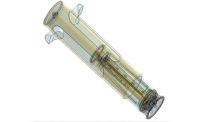Historic events make a Major League Baseball (MLB) season memorable. In October 2017, for instance, the Houston Astros won its first World Series championship ever. Several months before that, however, a less-well-known event took place: MLB approved the use of any Whoop Inc. wearable fitness tracker by all players and coaches in games.
Worn like a watch, the tracker features a sensor that measures an athlete’s heart rate, heart-rate variability, ambient temperature, motion, movement and skin response. It captures this data more than 100 times per second and sends the information to an app on the athlete’s iPhone or Android. Either device, in turn, provides data on strain and recovery to help the athlete balance training, reduce injuries and predict performance.
MLB approval of the tracker occurred only 2 years after it was invented and brought to market by Whoop founders Will Ahmed (CEO), John Capodilupo (CTO) and Aurelian Nicolae (product development engineer). All three are in their late 20s, attended Harvard University and developed the device at the school’s Innovation Lab, with the help of Proto Labs Inc. (PL).
From the beginning, the founding trio wanted the tracker to be something an athlete could wear all day, every day. Therefore, it needed to be recharged without being removed, and it had to be at least as accurate as chest-strap heart monitors used in clinics and hospitals.
Equally important, the device had to be small, trim and light—something that would fit easily onto the wrist, but not look like technology masquerading as fashion. Meeting all of these performance and appearance criteria proved challenging during the early design and testing phases.
“We’re in the wearable business, so all of our components have thin wall thicknesses,” explains Nicolae. “And, we wanted to design everything to be as small as possible.”
PL produced the tiny plastic parts for Whoop’s prototype to exact dimensions and with specified features, and delivered them quickly. The minimum size machined part PL makes is 0.25-inch square and 0.04-inch thick.
“In the development phase, we tried out all sorts of sensor configurations, sizes, size locations, housing designs and how they attach to the mostly fabric bracelets,” says Nicolae. “We quickly understood how accurate we were going to be in performance measurement.”
Also helpful was PL’s automated quoting system and its design for manufacturability analysis.
Brett Cochran, lead mechanical engineer at Whoop, estimates that these services saved more than two weeks in initial CAD model design analysis and overall prototyping.
Following alpha trials, Whoop moved forward with new designs. These required PL to switch from machining parts to molding aluminum bridge tools that produce pilot end-use build units. Nicolae says these units served as a bridge between prototypes and end-use products.
Since bringing its first tracker to market in 2015, Whoop has fully implemented the rapid manufacturing lessons it learned as a startup. The result is a company fully able to implement a 12-, 18- or 24-month speed-to-market cycle for any product, thereby staying competitive with the likes of more-well-known competitors Fitbit, Samsung, Apple and Garmin.
Currently, Whoop offers four models of fitness trackers: Strap 2.0, Hydroband, Tecnica and Nanostretch XL for biceps. All of them are regularly used by Olympic athletes, collegiate athletic conferences, and select teams and players from major pro sports leagues. Looking to further expand its market, the company is even developing products for the construction and other industries, with PL supplying parts.
For more information on custom prototypes and on-demand production parts, call 877-479-3680 or visit www.protolabs.com.




